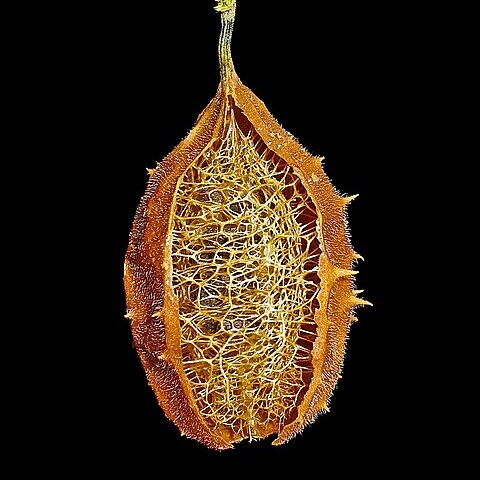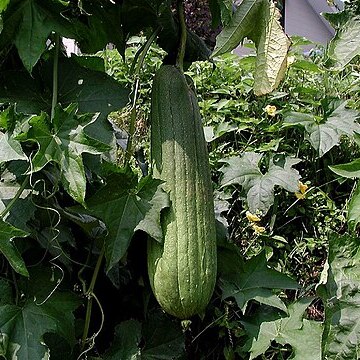Annual or subperennial, climbing herbs to 10 m long, leafy stem 2-5 mm diam., puberulous, late glabrescent, scabrid; monoecious (one species dioecious, not in our area); wild, cultivated or running wild. Probract fleshy, less than 5 mm long, with glands. Tendrils branched. Leaves: blade simple, mostly lobed. Flowers medium or large; petals folded in bud, yellow, free, margin entire. Inflorescences: male flowers in peduncled bracteate racemes; bracts narrowly ovate, to c. 5 mm long; female flowers solitary, often co-axillary with male inflorescence. Male flowers pedicelled; receptacle-tube small, shallow; sepals enclosing petals in bud; stamens 3 or 5: two in pairs and one single, the paired ones free or the filaments variously fused, then appearing as 3 stamens of which two 2-thecous, one 1-thecous, filaments free, inserted at base of the receptacle-tube, anthers free, but usually connivent into a subglobose synandrium, connective mostly broad, thecae marginal, convoluted-plicate; disc not apparent. Female flowers: receptacle-tube and perianth as in male flowers; ovary elongated or ovoid, smooth (or spiny not in Malesia), ovules numerous, horizontal; style short, stigma 3-parted, each part 2-lobed; staminodes small; disc absent. Fruit subglobose to (long-)cylindrical, smooth or ribbed (or with short spines), when ripe dry and fibrous within, dehiscing by an apical operculum. Seeds numerous, medium-sized, compressed, (narrowly) elliptic in outline, faces smooth or rugate, margin mostly distinct, edge entire.
Climbing or trailing herbs. Leaves simple; blade palmately lobed. Tendrils proximally 3–6-fid, less often bifid. Flowers medium to large yellow, monoecious. Male flowers racemose; receptacle-tube shortly campanulate; lobes relatively large, enclosing petals in bud, entire; petals 5, free, entire; stamens 5, all 1-thecous, in 2 pairs with one single, or the paired stamens variously united, when completely so stamens appearing as 3, 2 double 2-thecous, 1 single 1-thecous; filaments inserted on the tube, free; anthers free; connective broad; thecae marginal, much convoluted. Female flowers solitary; ovary smooth, ribbed, tuberculate or spiny; ovules many, horizontal; receptacle-tube short; stigmas 3, bilobed. Fruit medium-sized to large, subglobose to elongate-cylindrical, beaked, smooth, ribbed or sparsely to densely spiny with short to rather long spines, brownish, dry and fibrous, dehiscent by an apical operculum. Seeds medium-sized, distinctly compressed, oblong-elliptic in outline. Fig. 10.
Monoecious, tendriled vines: stems 5-to 10-sulcate. Leaves petiolate, simple, 5-to 7-lobate, rarely subentire; tendrils simple or 2-to 5-branched. Staminate flowers in racemes, axillary; calyx campanulate or turbinate, 5-lobate; petals 5, free; stamens 3 (in ours), borne on the hypanthium tube, free, the anthers linear, flexuous, variously unilocular or bilocular; pistillodium glanduliform or absent. Pistillate flowers solitary in the axils of the same leaves as the staminate inflores-cences; calyx and corolla similar to those of the staminate flowers; ovary elon-gate, 3-carpellate, the ovules numerous, horizontal, the styles 3, connate, the stigmas 3, bilobate; staminodia 3, rarely 4 or 5. Fruits cylindrical, fusiform, ellip-soidal, or clavate, smooth, tuberculate, echinate, or acutely ribbed, operulate at the apex, the style persistent, the interior filled with a coarse fibrous mass (vas-cular bundle net); seeds oblong, compressed, winged or wingless, the testa smooth or rugose.
Monoecious climbing annual herbs, scabrid. Tendrils 2-branched. Probracts present. Leaves simple, ovate, palmately 3–5-lobed, cordate, dentate. Male flowers in axillary bracteate racemes, rarely solitary; hypanthium broadly campanulate; calyx 5-lobed; petals 5, free, yellow; stamens 3, rarely 5, inserted towards base of hypanthium; connectives broad; anthers connivent, two bilocular, one unilocular when stamens 3, all unilocular when stamens 5; locules flexuose, triplicate or convolute; disc absent. Female flowers solitary, sometimes co-axillary with males; perianth similar to males; staminodes 3; ovary ovoid, attenuate; ovules numerous, horizontal; stigmas 3, bilobed. Fruit dry when ripe, ovoid to cylindrical-ellipsoidal, dehiscing by apical operculum; endocarp fibrous. Seeds many, ovoid, smooth.
Herbs, scandent, annual, glabrous or puberulent. Tendrils bi-or multifid. Petiole eglandular; leaf blade usually 5-7-lobed. Plants monoecious. Male flowers in a raceme; calyx tube obconical; segments 5, triangular or lanceolate; corolla segments 5, free, spreading, entire or erose; stamens 3 or 5, free; anthers: one 1-celled, other 2-celled or all 1-celled when stamens 5; anther cells linear, sigmoid-flexuous; connective usually dilated; pistillode glandular or absent. Female flowers solitary; calyx and corolla as in male flowers; staminodes 3, or rarely 4 or 5; ovary cylindric; ovules numerous, horizontal; stigmas 3. Fruit oblong or cylindric, terete or acutely costate, smooth or echinate, inside fibrous, apex operculately dehiscent. Seeds numerous, oblong, compressed.
Stamens 5, all one-thecous, or 3, 2 two-thecous & 1 one-thecous; filaments inserted on the receptacle-tube, free; anthers free; connectives broad; thecae much convoluted.
Fruit globose to cylindrical, rostrate, smooth, ribbed or spiny, dry, brownish, fibrous, dehiscent by an apical operculum.
Female flowers solitary; ovary smooth, ribbed, tuberculate or spiny; ovules many, horizontal; stigma 3-lobed.
Receptacle-tube broadly campanulate; lobes large, enclosing the petals in bud, entire.
Seeds compressed, oblong-elliptic in outline.
Flowers yellow or whitish, monoecious.
Annual prostrate or scandent herbs.
Tendrils proximally 2–6-fid.
Leaves simple, petiolate.
Petals 5, free, entire.
Male flowers racemose.


